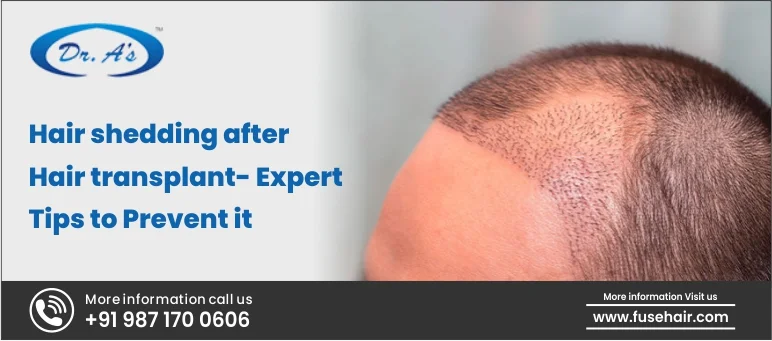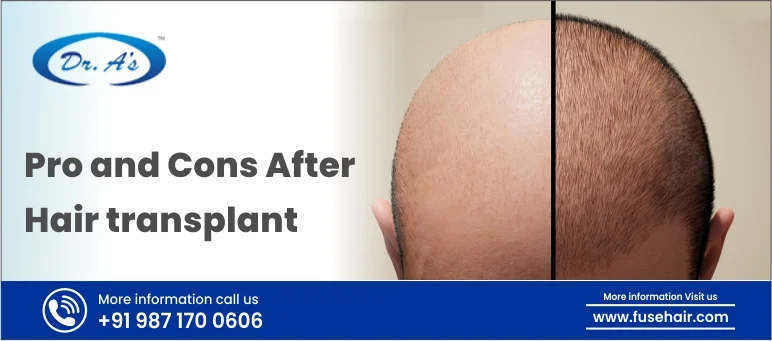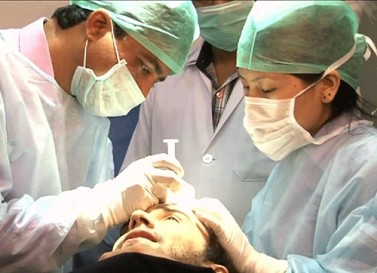
Many people worry about hair loss, and hair transplant surgery has become a popular way to encourage the growth of new, healthy hair. But one query that comes up frequently is, “How many hair transplant grafts are needed?” The level of hair loss, the desired hair density, the patient’s hair qualities, and the surgical technique used all have a role in the answer to this issue.
So, here, we will examine the specifics of hair grafts and the variables that affect the number of grafts required for a successful hair transplant.
Consulting a skilled hair transplant surgeon is essential to ascertain the precise number of grafts needed in each case. You can reach out to Dr. Arvind Poswal for the best treatment option and discuss the hair transplant graft cost.
How Many Hair Transplant Grafts Are Needed?
One common concern when considering a hair transplant is the number of grafts needed for the procedure. It depends on various factors, including the extent of hair loss, desired hair density, and the individual’s unique characteristics. Hair transplant surgeons often refer to the Norwood scale to estimate the required graft number and the final hair transplant cost.
So, let’s explore the Norwood scale and how it helps determine the graft requirement.
The Norwood Scale
The Norwood scale, also known as the Norwood-Hamilton scale, is a widely used classification system to assess the pattern and extent of male pattern baldness. It provides a visual representation of the different stages of hair loss and helps categorize hair transplant grafts based on their specific hair loss patterns. Dr. O’Tar Norwood initially developed the scale in the 1950s and later revised it by Dr. James Hamilton, resulting in the Norwood-Hamilton scale.
The Norwood scale consists of seven stages, ranging from minimal to extensive hair loss. Let’s take a closer look at each stage:
-
Norwood Stage 1
This stage represents no visible signs of hair loss. The hairline is in its natural position, and there are no noticeable thinning or receding areas. No hair transplant is required.
-
Norwood Stage 2
Hair loss becomes noticeable at the temples, forming a slight recession. However, the hairline remains relatively intact. It requires 500-1500 grafts.
-
Norwood Stage 3
The recession at the temples deepens further, resulting in a more significant hair loss in the frontal and temporal regions. The hairline may appear “M-shaped,” and 1500-2000 grafts may be required.
-
Norwood Stage 4
Hair loss becomes more pronounced at this stage, with a larger area of thinning or balding at the front and top of the scalp. The hairline continues to recede, and a bald spot may start to develop. It requires 2000-2500 grafts.
-
Norwood Stage 5
Hair loss is more extensive, with a significant bald spot forming at the top of the scalp. The remaining hair around the sides and back of the head becomes sparser, requiring 2800-3200 grafts.
-
Norwood Stage 6
Hair loss continues progressing, resulting in a more prominent bald spot on the top of the scalp. The remaining hair on the sides and back of the head may be limited to a horseshoe-shaped pattern. It will require 3500 to 4300 grafts.
-
Norwood Stage 7
This stage represents the most advanced form of hair loss, with only a band of hair remaining on the sides and back of the head. The bald spot at the top of the scalp merges with the receding hairline, resulting in extensive baldness and requiring 5000-6000 grafts.
Factors Affecting the Number of Grafts
While the exact number can vary depending on individual factors, it is essential to understand how many grafts are typically required and what factors contribute to this determination.
-
The Extent of Hair Loss
The extent of hair loss is one of the primary factors in determining the number of grafts needed. Hair loss can be categorized into various stages, such as the Norwood-Hamilton scale. These scales help assess the severity and pattern of hair loss, providing a basis for estimating the hair graft requirement.
-
Desired Hair Density
The desired hair density plays a significant role in determining the number of grafts needed. Some individuals may prefer a high-density result, while others may opt for a more natural-looking outcome with lower density.
Achieving higher density requires more grafts, as they must be placed closely together to create the appearance of thicker hair. On the other hand, a lower density may require fewer grafts, as they can be placed at a wider spacing.
Consult skilled hair transplant surgeons like Dr. Arvind Poswal to learn more about the grafts needed and the cost of hair transplant as per your hair density.
-
Hair Characteristics
The characteristics of a person’s hair, such as thickness, texture, and color, can influence the number of grafts needed. Individuals with thick, coarse hair often require fewer grafts to achieve adequate coverage and volume. The thickness of the hair strands provides better coverage and can result in a fuller appearance with fewer grafts.
In contrast, individuals with fair or light-coloured hair may need more grafts to achieve similar coverage and density. Discussing the cost of hair transplant with your surgeon before the procedure helps you to align the surgery with your budget.
-
Donor Supply
The donor supply refers to the availability of viable hair follicles in the donor area, typically the back and sides of the scalp. These areas are resistant to the effects of hair loss and serve as the source of hair follicles for transplantation. The number of grafts that can be harvested depends on the patient’s donor area characteristics, such as the density and laxity of the scalp.
Hair Transplant Options
Hair transplantation has become an effective solution for restoring natural hair growth. Several techniques are available for hair transplants, each with advantages and considerations. Let’s explore four common hair transplant options:
-
FUE (Follicular Unit Extraction)
FUE is a popular and minimally invasive hair transplant technique. A specialized punch tool extracts individual hair follicles from the donor area during FUE. This hair transplant cost per graft is Rs 25 to Rs 200.
The grafts are then carefully implanted into the recipient area. 1800-2000 grafts are harvested in a single session. FUE does not require the removal of a strip of scalp, making it a preferred choice for patients who prefer a shorter recovery time, minimal scarring, and the flexibility to wear their hair short.
Consult Dr. Arvind Poswal, who excels in the FUE technique, for more accurate hair transplant graft cost.
-
FUT (Follicular Unit Transplantation)
FUT is an older technique that involves removing a strip of skin from the donor area, typically the back of the scalp. The strip is then dissected into individual grafts for transplantation.
FUT allows for the extraction of 3000+ grafts in a single session, making it suitable for patients who require a higher graft count. This hair transplant cost per graft of FUT is Rs 20 to Rs 180.
-
FUHT (Follicular Unit Hair Transplantation)
FUHT is a combination technique that utilizes FUT and FUE methods. It involves extracting a strip of the scalp through the FUT technique and extracting additional grafts using the FUE technique.
FUHT allows for more grafts to be harvested, making it suitable for patients with extensive hair loss who require a high hair graft count. Combining techniques offers flexibility in graft harvesting and allows for customization based on individual patient needs.
-
FUSE (Follicular Unit Separation Extraction)
FUSE is a relatively newer technique that combines the principles of both FUE and FUT. It involves separating individual follicular units from the donor area without requiring a linear incision.
This technique aims to minimize trauma to the scalp and provide a higher graft yield. FUSE can be an excellent option for patients who require many hair grafts and desire minimal scarring.
Conclusion
The number of hair transplant grafts depends on several factors, including the extent of hair loss, desired hair density, hair characteristics, donor supply, and surgical technique.
Discussing with an experienced hair transplant surgeon is crucial to estimate the graft requirement and planning the surgery accordingly and accurately. By considering these factors and understanding the individual needs and goals of the patient, the surgeon can provide a personalized treatment plan and achieve successful hair restoration results.
Consult Dr Arvind Poswal for the best hair transplant treatment, which offers the minimum cost of hair transplant. With his 20 years of experience, you can fully trust him with the best results.









































































































































































